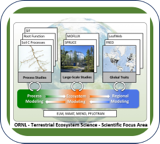The roles of photochemical and non-photochemical quenching in regulating photosynthesis depend on the phases of fluctuating light conditions
| Author | |
|---|---|
| Keywords | |
| Abstract |
Abstract The induction and relaxation of photochemistry and non-photochemical quenching (NPQ) are not instantaneous and require time to respond to fluctuating environments. There is a lack of integrated understanding on how photochemistry and NPQ influence photosynthesis in fluctuating environments. We measured the induction and relaxation of chlorophyll a fluorescence and gas exchange in poplar and cotton at varying temperatures under saturating and fluctuating lights. When the light shifted from dark to high, the fraction of open reaction centers in photosystem II (qL) gradually increased while NPQ increased suddenly and then remained stable. Temperature significantly changed the response of qL but not that of NPQ during the dark to high light transition. Increased qL led to higher photosynthesis but their precise relationship was affected by NPQ and temperature. qL was significantly related to biochemical capacity. Thus, qL appears to be a strong indicator of the activation of carboxylase, leading to the similar dynamics between qL and photosynthesis. When the light shifted from high to low intensity, NPQ is still engaged at a high level, causing a stronger decline in photosynthesis. Our finding suggests that the dynamic effects of photochemistry and NPQ on photosynthesis depend on the phases of environmental fluctuations and interactive effects of light and temperature. Across the full spectra of light fluctuation, the slow induction of qL is a more important limiting factor than the slow relaxation of NPQ for photosynthesis in typical ranges of temperature for photosynthesis. The findings provided a new perspective to improve photosynthetic productivity with molecular biology under natural fluctuating environments. |
| Year of Publication |
2021
|
| Journal |
Tree Physiology
|
| Volume |
42
|
| Issue |
4
|
| Number of Pages |
848-861
|
| ISSN Number |
1758-4469
|
| DOI |
10.1093/treephys/tpab133
|
| Download citation |

